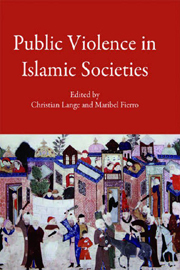 Public Violence in Islamic Societies
Public Violence in Islamic Societies Book contents
- Frontmatter
- Contents
- List of abbreviations
- Acknowledgements
- Introduction: Spatial, ritual and representational aspects of public violence in Islamic societies (7th–19th centuries ce)
- PART I Public violence and the construction of the public sphere
- PART II Ritual dimensions of violence
- 5 Reveal or conceal: public humiliation and banishment as punishments in early Islamic times
- 6 Emulating Abraham: the Fāṭimid al-Qāɔim and the Umayyad cAbd al-Raḥmān III
- 7 Where on earth is hell? State punishment and eschatology in the Islamic middle period
- 8 Justice, crime and punishment in 10th/16th-century Morocco
- PART III Representations of public violence
- Index
8 - Justice, crime and punishment in 10th/16th-century Morocco
from PART II - Ritual dimensions of violence
Published online by Cambridge University Press: 12 September 2012
- Frontmatter
- Contents
- List of abbreviations
- Acknowledgements
- Introduction: Spatial, ritual and representational aspects of public violence in Islamic societies (7th–19th centuries ce)
- PART I Public violence and the construction of the public sphere
- PART II Ritual dimensions of violence
- 5 Reveal or conceal: public humiliation and banishment as punishments in early Islamic times
- 6 Emulating Abraham: the Fāṭimid al-Qāɔim and the Umayyad cAbd al-Raḥmān III
- 7 Where on earth is hell? State punishment and eschatology in the Islamic middle period
- 8 Justice, crime and punishment in 10th/16th-century Morocco
- PART III Representations of public violence
- Index
Summary
In the second volume of Archives Berbéres, Louis Brunot describes a children's game from Fez, called sheffār-qammār: one by one, children sitting in a circle throw their slippers into the air. According to the way they fall back to the ground (with both soles downwards, with the uppers to the ground, or with one sole and one upper to the ground) each child will play the role of a sulṭān, a vizier or a thief. The rules of the game say that the thief will only be punished if there already exists a sulṭān or a vizier, in which case he will receive a series of strokes from a belt on the soles of his feet from the sulṭān. However, in the case where there is neither sulṭān nor vizier, the thief will not be punished. Finally, when a new sulṭān is elected, his predecessor will be dismissed after a good beating from the successor.
In its simplicity, this game from Fez shows the close link between the rise to power and the exercise of violence, as well as the dialectic links between order and disorder, between authority and anarchy. This dichotomy, whose nature is practically ideological, finally sanctions the legitimacy of power as representing a supreme order.
In the course of its exercise of violence, authority creates a discourse: it produces a text whose support is the body. This is a pedagogical discourse: it teaches and, by using indelible marks to do so, becomes part of memory.
- Type
- Chapter
- Information
- Public Violence in Islamic SocietiesPower, Discipline, and the Construction of the Public Sphere, 7th-19th Centuries CE, pp. 179 - 200Publisher: Edinburgh University PressPrint publication year: 2009


